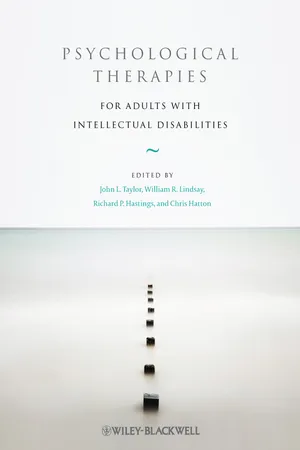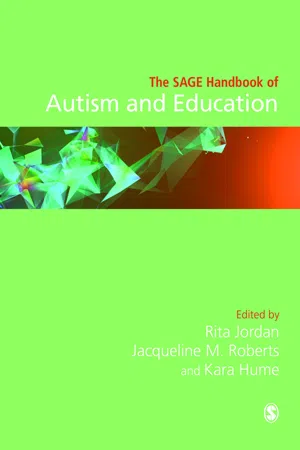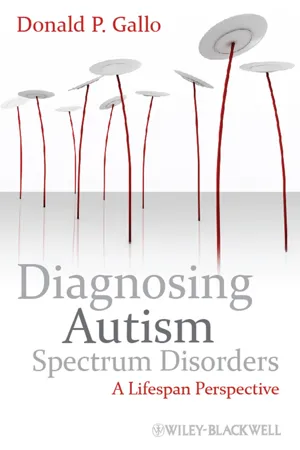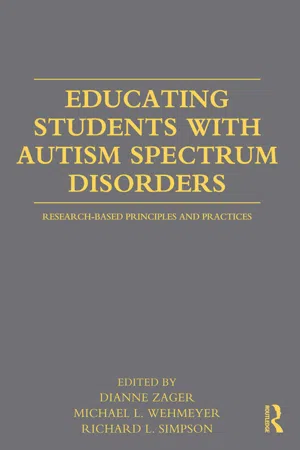Psychology
Individual Differences In Autism
Individual differences in autism refer to the wide range of characteristics and behaviors exhibited by individuals with autism spectrum disorder (ASD). These differences can include variations in communication skills, social interactions, sensory sensitivities, and repetitive behaviors. Understanding and recognizing these individual differences is crucial for providing tailored support and interventions for individuals with autism.
Written by Perlego with AI-assistance
Related key terms
9 Key excerpts on "Individual Differences In Autism"
- eBook - ePub
Neurodevelopmental Disorders
Research challenges and solutions
- Jo Van Herwegen, Deborah Riby(Authors)
- 2014(Publication Date)
- Psychology Press(Publisher)
2013 ). One touchstone for researchers and clinicians in the field over the past decade and more is that autism is very heterogeneous or variable. This variability includes both aetiology and phenotypic presentation – both in terms of the range and characteristics of individuals who meet the diagnostic criteria for the disorder and in terms of individual variability and outcome over the course of development. To clinicians and researchers, this heterogeneity presents both challenges and opportunities. In the present chapter we outline recent work on variability in Autism Spectrum Disorders (ASD). We emphasise the impact this has on our understanding of its prevalence, causes, diagnosis, cognitive and behavioural profile, and in particular, its developmental trajectory across the lifespan.7.2 Definitions and diagnosis
A clear sign of how heterogeneity in autism is being embraced is reflected in the changes to its classification and diagnosis in the recent revision of the DSM. Previous DSM-IV-TR (APA, 2000 ) and ICD-10 (WHO, 1993 ) definitions included ‘core autism’ (‘autistic disorder’ in DSM-IV; ‘childhood autism’ in ICD-10) and a number of other putative subtypes of ‘pervasive developmental disorder’, including Asperger syndrome, but DSM-5 has been changed to a unified diagnosis of Autism Spectrum Disorder (ASD) (DSM-5; APA, 2013 ). This was based on a number of research findings; not least the evidence that even amongst expert groups the use of the sub-classifications in DSM-IV was unreliable (Lord et al., 2012 ). Foremost amongst the changes to the diagnostic classification are the replacement of the ASD triad with an ASD dyad, comprising social communication and restricted repetitive behaviour (RRB) domains, and the inclusion of hypo- or hyper-reactivity to sensory stimuli as a core diagnostic criterion within the RRB domain.Like the majority of neuropsychiatric disorders, ASD is defined as a behavioural syndrome, such that a specific cluster of signs and symptoms are assumed to signify a latent disease entity (Kendell & Jablensky, 2003 ). The term ASD is now used to describe a range of neurodevelopmental conditions that demonstrate considerable phenotypic heterogeneity; both in terms of presentation at any one age and across development and which are likely to differ in underlying aetiology. This heterogeneity has prompted biological scientists to coin the term ‘the autisms’ (Geschwind & Levitt, 2007 ), which serves as a helpful reminder that we are not dealing with a unitary ‘disease condition’. However, all individuals with ASD share what some consider a primary impairment in social relatedness and reciprocity, alongside impairments in the use of language for communication and an ‘insistence on sameness’, which is in keeping with Kanner’s (1943 ) original description of classically ‘autistic’ children. The presence of social and communication abnormalities, in combination with limited imagination and generativity, was previously characterised as the ‘triad of impairments’ by Wing and Gould (1979 - eBook - ePub
Child and Adolescent Psychopathology
Theoretical and Clinical Implications
- Cecilia A. Essau(Author)
- 2012(Publication Date)
- Routledge(Publisher)
10 Autism A psychological perspectiveHanna Kovshoff, Corinna F. Grindle, and Richard P. HastingsFirst identified in 1943 by Leo Kanner, autism affects an individual’s ability to communicate verbally and non-verbally, interact socially, play imaginatively, and relate to those around them. Autism is a spectrum disorder such that it affects individuals differently, and with varying degrees of severity. It is estimated that between 3.3 and 16 children per 10,000 are affected with autism, taking into account differing diagnostic criteria, genetic factors, environmental influences, and/or case finding methods of a range of epidemiological studies. The latest incidence rates of persons living with autism spectrum disorders in the United Kingdom, according to the National Autistic Society, are 91 per 10,000, and 1 in 1000 (Bryson, 1997) in the United States. Autism is three to five times more likely to affect boys than girls (American Psychiatric Association 1994; Klinger and Dawson, 1996).Autism is not a behavioural disorder; however, diagnosis relies on the presence, as well as the absence, of various key behaviours. It is a lifelong, complex neurodevelopmental disability, which affects central nervous system and brain functioning. Behaviours commonly associated with autism may become apparent by the time the child reaches the age of 18 months, and are usually present by 3 years of age. As described in the DSM-IV (APA, 1994) and the ICD-10 (WHO, 1992) diagnostic manuals, autism is characterized by a pattern of deficits in social behaviour, communication, and imagination, and is associated with repetitive and/or stereotypical patterns of behaviours or interests. Autism forms part of a subcategory of Pervasive Developmental Disorders (DSM-IV; APA, 1994) which are characterized by severe and lifelong impairment in multiple areas of development. These areas of impairment are relative to the individual’s developmental level or mental age (DSM-IV; APA, 1994). Apart from autism spectrum disorder, pervasive developmental disorders include Rett’s disorder, child disintegrative disorder, Asperger’s disorder, and pervasive developmental disorder – not otherwise specified (PDD-NOS). All of these conditions have in common that they are evident in the first year of life, and most are associated with some level of intellectual disability. Autism occurs at all intelligence levels, although it is widely believed that approximately 75 percent of persons with autism also have associated learning difficulties and a below average intelligence quotient (IQ), while approximately 25 percent of individuals with autism have average or above average intelligence (Newsom, 1998; Sigman, 1998). It is noteworthy to say that tests of intelligence and cognitive potential find a different pattern of performance than other children with intellectual disabilities. Autism is associated with a pattern of strengths and weaknesses characterized by deficits in abstract and conceptual thinking, receptive and expressive language, and socially related tasks. Conversely, non-verbal performance, and visual spatial and motor skill areas are often better developed (Happé, 1994; Shah and Frith, 1993; Volkmar et al., 1997). - eBook - ePub
Making Sense of Social Situations
How to Run a Group-Based Intervention Program for Children with Autism Spectrum Disorders
- Albert Cotugno(Author)
- 2011(Publication Date)
- Jessica Kingsley Publishers(Publisher)
Part II Understanding Individuals with Autism Spectrum Disorders (ASD)Part II focuses on how to understand and address several key components that emerge in group interventions with individuals with ASD. First, general areas of functioning important for every individual’s development are considered, but from the perspective of the individual with ASD. The focus here is on seven main areas of functioning, referred to as core areas. Each is described briefly. Specific core variables (often referred to in the ASD literature as core deficits) within each core area that relate specifically to the individual with ASD and appear most important are then defined and discussed.Each of the core variables emphasized in this approach (self-regulation; emotion competence; stress and anxiety control and management; attention; joint attention; flexibility, change, and transition; perspective taking; and relatedness/empathy) is highlighted and described. While this is not assumed or intended to be an exhaustive list of possible variables that could be addressed, these variables in particular are considered of primary importance to address and manage if appropriate group and social interactions, social competencies, and social skills are to be acquired.Each core variable is initially considered separately as it applies to individuals with ASD through a cognitive-developmental perspective. Issues of management and treatment are then considered and how they apply to the group-focused, peer-based, cognitive-developmental stage model that will be described in later chapters.Passage contains an image Chapter 3 The Core Areas of Development and Related Deficits of ASD
With its beginnings in gestation, human development is a complex process of interrelated functions that develop, change, and evolve, continuously moving toward increased differentiation and complexity and affected by genetic, familial, social, environmental, and behavioral factors. There are seven main areas of development that individuals proceed through from birth through the lifespan. Each of these areas may be discussed as if they proceed through their own individual path of development; however, most are reliant and dependent on several other areas for their capacity to proceed forward. - John L. Taylor, William R. Lindsay, Richard P. Hastings, Chris Hatton(Authors)
- 2012(Publication Date)
- Wiley-Blackwell(Publisher)
et al ., 2001). Thus, the provision of appropriate individual therapeutic work is but one part of the appropriate response to meeting these needs, but it is an important one that presents many specific challenges for therapists. It is not the author’s intention to provide an account of cognitive–behavioral therapy (CBT) per se nor to present any form of manualized therapy for people with ASD, but rather to discuss some of the issues that frequently arise in therapeutic work with people with ASD, including those who are not intellectually disabled. In order to do this, it is first necessary to understand both the nature of the condition itself and the difficulties associated with it.Definition of ASDs
Autism was first defined as a developmental disorder, as opposed to the description of a psychological state, in the mid-1940s, with the term Asperger’s syndrome being later used to describe people with ASD who are not intellectually disabled (Wing, 1981). It is important to note that both semantic–pragmatic disorder , as characterized by poor conversational skills and inappropriate language usage (e.g., endless questioning and stereotypical utterances) but normal articulation and syntax, and nonverbal learning disability , as characterized by deficits in social functioning, communication, and interaction are probably but partial descriptions of Asperger’s syndrome (Volkmar & Klin, 1998). Differentiation of subgroups within the broad autism spectrum is still ongoing, with the recent emergence of multiple and complex developmental disorder (Sturm et al ., 2004), a syndrome characterized by distinct affective problems in childhood with apparently psychotic features in adulthood. Empirical and clinical studies of multiple and complex developmental disorder are limited at the time of writing, and no specifically psychological interventions have been developed.Case Example 1: Eileen
Eileen is a young woman aged 22 with a diagnosis of autism who previously attended a special school and who is now enrolled on a local college course for young adults with intellectual disabilities. She lives at home and has abiding interests in UFOs, reading television listings magazines, and collecting pens and pencils. For several weeks, she has been refusing to attend college and has stayed in her room engaging in sorting her vast collection of pens. She says that she is scared of going into town and college, but she regularly goes out at night to look for UFOs from a nearby park.- eBook - ePub
Inclusion and Autism Spectrum Disorder
Proactive Strategies to Support Students
- Christopher B. Denning, Amelia K. Moody(Authors)
- 2018(Publication Date)
- Routledge(Publisher)
The most recent definition of autism by the American Psychological Association (2013) (APA) made changes that will have effects on the classroom. First, the four categories included in previous definitions (Autistic disorder, Asperger syndrome, child disintegrative disorder, pervasive developmental disorders) are now combined under the over-arching term of Autism Spectrum Disorder or ASD. This means that students will not be identified as having Asperger syndrome or pervasive developmental disorder. These terms helped to define many children and adults, but research failed to consistently discriminate how they differed from autism. Second, the new definition includes two main categories that replace the previous three. “Social and communication deficits” were combined into one category and “fixated interests and repetitive behaviors” remained as a separate category. These can include problems with social reciprocity, non-verbal communication, establishing and maintaining relationships, repetitive movements or speech, difficulty with change, restricted and fixated interests, and hyper- or hypo-sensitivity to environmental stimuli. Third, “language impairment /delay” is no longer included in the diagnosis.Characteristics continue to include communication, social skills, and behavioral deficits across a spectrum of intensity however, and the new definition includes three severity levels: (a) Level 1, which requires support, (b) level 2, which requires substantial support, and (c) level 3, which requires very substantial support. Additional changes were also made, such as adding “unusual sensitivity to sensory stimuli” as a clinical feature, and a new category of “social communication disorder” that may replace a label under the ASD umbrella for some children. It is unclear how these changes will impact identification and support (Vivanti et al., 2013). See Table 1.1 - eBook - ePub
- Rita Jordan, Jacqueline M. Roberts, Kara Hume(Authors)
- 2019(Publication Date)
- SAGE Publications Ltd(Publisher)
For autistic scholar and activist Steve Graby, autism can be said to fall between the established categories of ‘impairment’ and ‘disability’ (2012), with activists reclaiming what is also a medical categorisation as a cultural identity. Graby (2012) suggests that where impairment-specific organisations exist, they usually follow an individual/medical model approach and thus are often frowned upon by those following a social model of disability, where differences between impairments are viewed as less important than an analysis of social disablement. Autistic activists, however, commonly draw upon a social model of disability (Milton, 2016), while also referring to autism-specific issues. For Graby (2012), there are a number of considerations when looking at autism and autistic people: firstly, autism is defined medically as a ‘social impairment’ and therefore might be seen as in need of sociological analysis; secondly, there is the creation of autistic culture, communities and political movements; and finally, the significant reclaiming of what autism pertains to, and the cultural acceptance within autistic communities of peer recognition and self-diagnosis. Importantly, Graby (2012) also points out that not all autistic people personally identify as being ‘disabled', with autism often being presented as a cognitive and cultural minority rather than being seen as a set of impairments. Graby (2012) illustrates a linguistic difference, in that when one refers to ‘disabled people’ one is frequently illustrating things ‘done to’ a person, rather than a positive affirmation of identity, as is the case with the use of ‘autistic person'. Such a view of autism is more akin to the ‘affirmation model of disability’ as proposed by Swain and French (2000), and developed by Cameron (2008). In this sense, autism is seen as a natural aspect of human diversity.Deficit Models of Autism and Alternative Explanations
One of the most important developments in the history of autism was the work of Wing and Gould (1979) and the subsequent widening of the autism spectrum to include Asperger syndrome. This work largely created the discourse of a triad of impairments in autism: social communication, social interaction and social imagination (repetitive interests/activities).Autistic children do have imagination, but it is not social. (Wing, cited in Feinstein, 2010: 152)Autism has since become defined as primarily a social ‘disorder', with other important aspects of autistic experience having received relatively less attention, such as sensory processing, being absent in diagnostic criteria until fairly recently (DSM-V: American Psychiatric Association, 2013). A diagnosis of autism is dependent on a clinician perceiving a client to be both dysfunctional in terms of normative communication and interaction and in terms of perceived repetitive behaviours and interests being observed.Models of autism that attempt to explain what autism ‘is’ have been dominated by theories originating in cognitive–psychological theorising. These models include: theory of mind deficit, executive dysfunction, weak coherence theory, and empathising–systemising theory. All of these theories have been previously criticised by autistic scholars (Lawson, 2010; Milton, 2012a; 2012b) for their lack of universality, specificity and explanatory power in describing autism. According to autistic scholars and activists drawing upon social and/or post-social models of disability (Lawson, 2010; Arnold, 2012; Graby, 2012; Milton, 2012a, 2012b), autism can be seen both as a social construction and as a description of an embodied and culturally filtered experience. Therefore, presenting autism as purely a set of behavioural and cognitive deficits does not take into account the disabling affects that any given society or context holds for autistic people: - eBook - ePub
Autism Spectrum Disorders
Identification, Education, and Treatment
- Dianne Zager, David F. Cihak, Angi Stone-MacDonald, Dianne Zager, David F. Cihak, Angi Stone-MacDonald(Authors)
- 2016(Publication Date)
- Routledge(Publisher)
Chapter 1Definitions and Classification of Autism Spectrum Disorders Melissa P. Maye, Ivy Giserman Kiss, and Alice S. CarterAutism Spectrum Disorder, a new diagnosis in the fifth edition of the Diagnostic and Statistical Manual (DSM-5), was developed to classify individuals with impairments due to difficulties with social communication and social interaction, as well as the presence of restrictive and repetitive behaviors, interests, or activities (American Psychiatric Association, 2013). Autism Spectrum Disorder (ASD) replaces a set of diagnoses that were included in the fourth edition of the Diagnostic and Statistical Manual (DSM-IV), including Autistic Disorder, Pervasive Developmental Disorder (PDD) – Not Otherwise Specified, and Asperger’s Disorder (APA, 2000). These diagnoses were previously grouped together within a category labeled Pervasive Developmental Disorders. At present, it is estimated that one in 68 children (one in 42 boys; one in 189 girls) have an ASD diagnosis (Center for Disease Control, 2014).In this chapter, the ways in which the conceptualization of the construct autism has changed over the last century are explored, and modifications made to the diagnostic criteria in each edition of the DSM are described. Special emphasis is placed on the most recent changes introduced in the DSM-5 in 2013. Symptom criteria that are used to diagnose Autism Spectrum Disorder in the DSM-5 are described in detail.A number of screening tools and diagnostic measures have been developed to aid clinicians and researchers in making earlier and more accurate diagnoses of the previous diagnosis of PDD and the current diagnosis of ASD (e.g., Lord et al., 2012; Lord, Rutter, & Le Couteur et al., 1994; Luyster et al., 2009; Robins et al., 2014; Rutter, Bailey, Lord, Cianchetti, & Fancello, 2007; Schopler, Van Bourgondien, Wellman, & Love, 2010; Stone, Coonrod, & Turner; 2004; Stone, McMahon, & Henderson, 2008). In addition to reviewing historical shifts in diagnostic criteria and conceptualizations, this chapter presents three diagnostic measures that are widely used in diagnostic assessment and have strong evidentiary bases. It is important to note that while these diagnostic measures are extremely useful as aids in clinical decision-making, they are not considered diagnostic instruments. They should be used to inform, rather than to replace, clinical judgment. - eBook - ePub
Diagnosing Autism Spectrum Disorders
A Lifespan Perspective
- Donald P. Gallo(Author)
- 2015(Publication Date)
- Wiley(Publisher)
Could the diagnosis of PDD-NOS also be used with an older individual who was diagnosed with autism in the past, received a significant amount of services over the years and has made great progress because of those services? Or would diagnosing that person with high-functioning autism be more appropriate, because of the great progress they have made? We always need to keep the patient’s history in mind, and that history never changes. If the individual met all of the criteria in the past for a diagnosis of autism, then that would continue to be the most appropriate diagnosis.The individuals who view Asperger’s disorder as a higher-functioning form of autism might think that an autistic individual who has received services and has shown tremendous improvement would now qualify for a diagnosis of Asperger’s. While on the surface that may sound reasonable, it really does not make any diagnostic sense. This individual who did not speak until the age of four, but is now highly verbal, still has a developmental history of a speech delay, regardless of how well they are doing years or decades later. That history of a language delay would continue to rule out a diagnosis of Asperger’s disorder and suggests that this is a person with a previous diagnosis of autism who is doing very well and is only “mildly affected.” In fact, this is really how people are supposed to progress, given the remitting nature of the autism spectrum.ASDs and/or ADHD
There can be a great deal of overlap between the symptoms of all three forms of ADHD (the combined type, the hyperactive-impulsive type, and the inattentive type) and the ASDs. According to the DSM-IV-TR, “Attention-Deficit/Hyperactivity Disorder is not diagnosed if the symptoms of inattention and hyperactivity occur exclusively during the course of a Pervasive Developmental Disorder or a Psychotic Disorder” (p. 91). But what if the signs of ADHD occur separate from the PDD? Before we approach such complicated matters, let’s take a closer look at ADHD and how it differs from the autism spectrum.Individuals who have ADHD need to show at least six of nine symptoms of inattention, hyperactivity/impulsivity, or both before the age of seven. If the child has significant deficits in these areas, it is quite likely that the problems will become much more apparent by the time they enter kindergarten, typically by the age of five. The DSM-IV-TR - eBook - ePub
Educating Students with Autism Spectrum Disorders
Research-Based Principles and Practices
- Dianne Zager, Michael L. Wehmeyer, Richard L. Simpson(Authors)
- 2012(Publication Date)
- Routledge(Publisher)
As a description and overview of the identification, screening, and diagnostic process we employ two case studies: John, a 24-month-old boy, and Kelly, a 13-year-old girl. Diagnostic Classification: An Overview and Historical Background Autism spectrum disorders (ASD) are clinically diagnosed based on criteria described in DSM-IV-TR (2000) and in ICD-10 (1990). The DSM and ICD classification systems are similar; however, below we discuss the DSM-IV classification because of its wide-scale use in North America. Educators also routinely rely on DSM criteria for ASD, albeit educational diagnoses fall under the Individuals with Disabilities Education Act (1990). Autistic Disorder According to the current DSM (American Psychiatric Association, 2000) autistic disorder is characterized by the presence of symptoms in three domains: communication, social interaction, and restricted and repetitive patterns of behavior and interests. Moreover, onset of symptoms must occur before the age of 3. Manifestation of symptoms in this triad of impairments varies greatly depending on chronological and developmental age as well as myriad other factors such as the nature and severity of an individual’s disability. Difficulties in the communication domain for a toddler may include late onset of single word use and phrase speech, diminished use of pointing, and limited attempts to direct another person’s attention to objects or events of interest to the child. Examples of communication symptoms in an older individual with phrase speech are speech abnormalities such as irregularities in rhythm, odd intonation, inappropriate pitch, pronoun reversal (e.g., “you” to mean “I”), and difficulties in sustaining a reciprocal conversation. Impairments in social interaction in a young child may include delayed or no response to having his or her name called, and absence of behaviors such as giving and showing objects to another person
Learn about this page
Index pages curate the most relevant extracts from our library of academic textbooks. They’ve been created using an in-house natural language model (NLM), each adding context and meaning to key research topics.








